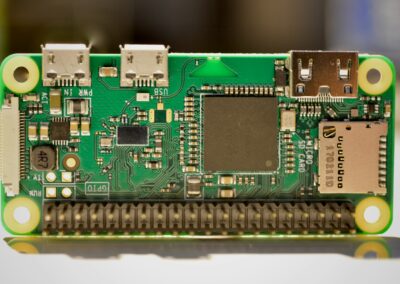Strategies for Seamless Integration of IoT Devices with Legacy Systems
Ensuring compatibility and interoperability of IoT devices with legacy systems is crucial for businesses aiming to leverage modern technologies without discarding their existing infrastructure. This challenge is particularly pertinent in regions like Saudi Arabia and the UAE, where rapid technological advancements coexist with established systems. To address this, organizations must adopt comprehensive strategies that facilitate the seamless integration of IoT devices with legacy systems, ensuring operational continuity and enhanced efficiency.
One of the primary strategies involves implementing middleware solutions that act as a bridge between IoT devices and legacy systems. Middleware can translate data formats and communication protocols, enabling smooth data flow and interoperability. For instance, in Riyadh’s healthcare sector, middleware solutions can integrate modern IoT health monitoring devices with existing electronic health record (EHR) systems, enhancing patient care without overhauling the entire IT infrastructure.
Another effective approach is leveraging open standards and protocols that promote interoperability. Using widely accepted standards such as MQTT, CoAP, and OPC UA ensures that IoT devices can communicate with legacy systems regardless of manufacturer-specific technologies. This is particularly beneficial in Dubai’s smart city projects, where diverse IoT applications in transportation, energy, and public services need to interact seamlessly to deliver integrated solutions. By adhering to open standards, businesses can future-proof their investments and ensure long-term compatibility.
Adopting API-Led Connectivity
API-led connectivity is another vital strategy for ensuring compatibility and interoperability of IoT devices with legacy systems. APIs (Application Programming Interfaces) facilitate communication between different software applications, enabling IoT devices to interact with legacy systems efficiently. In the UAE’s manufacturing sector, for example, using APIs allows modern IoT sensors to gather real-time data from production lines and feed it into legacy enterprise resource planning (ERP) systems, optimizing production processes and reducing downtime.
Organizations can develop custom APIs tailored to their specific needs, ensuring that IoT devices can access and utilize data from legacy systems. Additionally, adopting API management platforms helps streamline the creation, deployment, and monitoring of APIs, enhancing security and scalability. This approach not only ensures interoperability but also provides a scalable framework for integrating future technologies.
Furthermore, utilizing cloud-based IoT platforms that support API integration can simplify the process. These platforms offer pre-built connectors and APIs for various legacy systems, reducing the complexity and time required for integration. In Saudi Arabia’s energy sector, cloud-based IoT platforms can integrate smart grid technologies with existing utility management systems, enabling real-time monitoring and efficient energy distribution.
Implementing Edge Computing
Edge computing plays a pivotal role in ensuring compatibility and interoperability of IoT devices with legacy systems by processing data closer to the source. This reduces latency and bandwidth usage, allowing IoT devices to operate effectively alongside legacy systems. In Dubai’s transportation sector, edge computing can facilitate real-time traffic management by processing data from IoT sensors on the edge, then integrating it with legacy traffic control systems to improve urban mobility.
By deploying edge computing solutions, organizations can ensure that IoT devices provide timely and accurate data to legacy systems, enhancing decision-making and operational efficiency. Edge gateways can also act as intermediaries, translating data formats and protocols between IoT devices and legacy systems, ensuring seamless interoperability. This approach is particularly beneficial in scenarios where real-time data processing is critical, such as in industrial automation and smart city applications.
Moreover, edge computing enhances data security by keeping sensitive information closer to the source and reducing the need for data transmission over potentially insecure networks. In Saudi Arabia’s financial sector, for example, edge computing can secure transactions by processing and encrypting data at the edge before sending it to legacy banking systems, mitigating the risk of data breaches and cyberattacks.
Ensuring Scalability and Flexibility
Scalability and flexibility are essential considerations when ensuring compatibility and interoperability of IoT devices with legacy systems. Organizations must design their IoT solutions to accommodate future growth and technological advancements. This involves choosing scalable middleware, API, and edge computing solutions that can adapt to increasing data volumes and evolving business needs.
In Riyadh’s smart building initiatives, ensuring scalability means that IoT devices used for energy management, security, and occupant comfort can integrate with existing building management systems and expand as new technologies emerge. Flexible integration solutions allow businesses to add new IoT devices or functionalities without disrupting existing operations, ensuring a smooth transition to more advanced smart building technologies.
Additionally, implementing modular integration frameworks enables organizations to customize their IoT solutions to specific industry requirements and use cases. In Dubai’s retail sector, for instance, modular IoT platforms can integrate with legacy point-of-sale (POS) systems to provide real-time inventory management and personalized customer experiences. This flexibility ensures that businesses can tailor their IoT implementations to meet unique operational demands.
Conclusion
In conclusion, ensuring compatibility and interoperability of IoT devices with legacy systems is a multifaceted challenge that requires strategic planning and implementation. By adopting middleware solutions, leveraging open standards, utilizing API-led connectivity, and implementing edge computing, organizations can achieve seamless integration and enhance their operational capabilities. In regions like Saudi Arabia and the UAE, where technological innovation and legacy infrastructure coexist, these strategies are essential for driving digital transformation and achieving business success.
#IoTCompatibility #IoTInteroperability #SmartTechnologyIntegration #BusinessTransformation #SaudiArabiaTech #UAEInnovation #RiyadhTechnology #DubaiSmartCity #DigitalTransformation #AI #Blockchain #GenerativeAI #ExecutiveCoaching #ModernTechnology #BusinessSuccess #LeadershipSkills #ProjectManagement































